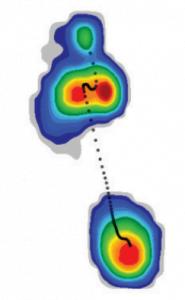What is the COP curve in foot pressure analysis platforms and what are its uses? (1)
If you are a user of foot pressure analysis platforms, you must have noticed the dotted COP curves in the dynamic pressure contours of your device. This post is the first of a series of educational materials related to the introduction of the COP curve, diagnostic indices, how to interpret it, as well as the studies done on it for better use of the data collected by pressure analysis platforms and precise design. Specific therapeutic orthoses are published by Aramad Research Academy.
ft scanner

What is the COP parameter?
COP parameter stands for Center of Pressure. In fact, the COP represents a point at each moment of a person’s stride. This point is the position of the effect of all the vertical forces exchanged between the foot and the ground. So that we can equate all the forces and torques coming from the ground to the body at that point.
What is the COP curve?
As mentioned, COP represents a point at any moment. Therefore, it is natural that if we measure the COP at any moment in time, by placing the COP points together, we will see a dotted curve, like the one shown in the figure below. The number of points in each COP curve depends on the stepping time as well as the data acquisition frequency of the device. The higher the data collection frequency of the foot pressure analysis platform, the more it will be possible to analyze fast foot movements

Compression of points on the COP curve
According to the working frequency of the foot pressure analysis platform, the COP position is measured and displayed at regular intervals. For example, if the device works with a frequency of 100 images per second, in this case, the COP position is measured once every hundredth of a second. In this way, the large distances of the points in the COP curve indicate the fast movement of the step in each phase, and the compression of the points indicates the longer time the body remains in that movement phase.

Does COP only depend on the position or shape of the foot?
No, in answer to this question, it should be said that the position of COP is a complex part of the movement system, including the skeletal-muscular system and the body’s nervous system, which ultimately shows its effect in the distribution of foot pressure. Therefore, the analysis of this trajectory contains valuable diagnostic points about the state of the nervous system as well as the musculoskeletal system of the body.
What is the diagnostic function of COP?
Identifying the diagnostic functions of COP is one of the current research topics in neuroscience, physical medicine, and orthotics and prosthetics. Among the important functions of the pathological evaluation of COP, one can diagnose abnormalities and disorders of the nervous system in chronic neurological diseases, motor rehabilitation, identification of movement disorders in the foot (such as pronation and supination), balance measurements (Fall Prevention) and… cited. In the following articles, we will discuss the diagnostic functions of COP and its analysis and interpretation methods.

